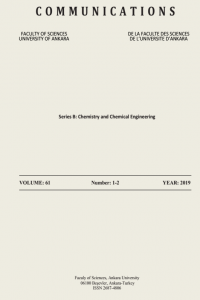Korozyon inhibitörleri havaya açık sodyum klorür çözeltisinde metal yüzeyinde kapatıcı katman oluşturarak etkimektedir. Bu çalışmada da Co+2, Ni+2, La+3 ve Ce+3 metal katyonlarının atmosfere açık 1 M NaCl çözeltisinde alüminyum ve alüminyum alaşımlarının korozyonuna etkisi polarizasyon ölçümleri ile araştırıldı. Metal katyonlarının inhibitör etkisi 1 M NaCl de elde edilen akım-potansiyel eğrilerinden belirlenmiş olan korozyon karakteristikleriyle incelendi. Elektrokimyasal veriler metal katyonlarının alüminyum ve alüminyum alaşımlarının korozyonu azatlığını gösterdi.
INHIBITION EFFECTS OF Co+2, Ni+2 La+3 AND Ce+3 IONS ON THE CORROSION OF ALUMINIUM AND ALUMINIUM ALLOYS IN THE NaCl SOLUTION
Corrosion inhibitors are widely used in aerated neutral sodium cloride solution. In this study, the effect of metal cations Co+2, Ni+2, La+3 and Ce+3 on the corrosion of aluminium and its alloys in an aerated 1 M NaCl solution were investigated by polarisation measurements. The inhibition efficiencies of metal cations were investigated by obtaining current-potential curves in 1M NaCl solution and by calculating corrosion characteristics from current-potential curves. Electrochemical studies showed these cations to axhibit inhibitive effect on the corrosion of aluminium alloys in the studied solution.
Keywords:
Aluminium alloys Inhibition, Corrosion resistance, Metal cations,
___
- [1] S. A. Ali, M. T. Saeed, S. V Rahman., Corros. Sci. 45 (2003) 253.
- [2] V. S. Sastry, corrosion inhibitors-Principles and Aplication, Jhon Wiley and Sons, 1998.
- [3] C. C. Nathan, corrosion Inhibitors, NACE, Huston, TX, 1973
- [4] D.R. Arnott, B.R.W. Hinton and N.E. Ryan, Corrosion 45, 12 (1989).
- [5] F. Mansfeld, S. Lin, S. Kim and H. Shih, Corrosion 45, 615 (1989).
- [6] A.J. Davenport, H.S. Isaacs and M.W. Kending, Corros. Sci. 32, 653 (1991).
- [7] A.J. Aldykiewicz, H.S. Isaacs and A.J. Davenport, J. Electrochem. Soc. 142, 3342 (1995).
- [8] D. R. Arnott, N. E. Ryan, B. R. W. Hinton, B. A. Sexton, A.E. Hughes, Appl. Surf. Sci. 22/23 (1985) 263.
- [9] D. R. Arnott, B. R. W. Hinton, N. E. Ryan, Corrosion 45 (1989) 12.
- [10] B. R. W. Hinton, L. Wilson, Corros. Sci. 29 (1989) 967.
- [11] A. J. Aldykiewicz, H.S. Isaacs, A.J. Davenport, J. Electrochem. Soc. 142 (1995) 3342.
- [12] M. Bethencourt, F.J. Botana, J.J. Calvino, M. Marcos, M.A. RodriguezChacon. Corros. Sci. 40 (1998) 1803.
- [13] M.S. Powell, H.N. McMurray, D.A. Worsley, Corrosion 55 (1999) 1040.
- [14] M.A. Arenas, M. Bethencourt, F.J. Botana, J. de Damborenea, M. Marcos, Corros. Sci. 43 (2001) 157.
- [15] K. Aramaki, Corrosion Science 43 (2001) 1573
- [16] G. Williams, H.N. McMurray, D.A. Worsley, J. Electrochem. Soc. 149 (2002) B154.
- [17] Greenwood, N.N. and Earnshaw, A., Chemistry of the Elements. Pargamon Pres, Oxford, England, 1984, p. 1437.
- [18] Haley, T.J. Jour. Pharm. Sci., 1965. 54, 633.
- [19] DHHS-NIOSH. Reg. of Tocxic Effects of Chemical Substarances, Vol. 86. DHHS-NIOSH Pub., 1986, p. 103.
- [20] Falconnet, P.J.Jour. Alloys and Comp.,1993, 192, 114.
- [21] D. M. Drazic, L. Z. Vorkapic, Corros. Sci. 18 (1978) 907
- [22] M. F. Montemor, W. Trabelsi, M. Zheludeich, M. G. S. Ferreira Prog. Org. Coat. 57 (2006) 67- 77
- ISSN: 1303-6017
- Başlangıç: 1948
- Yayıncı: Ankara Üniversitesi
